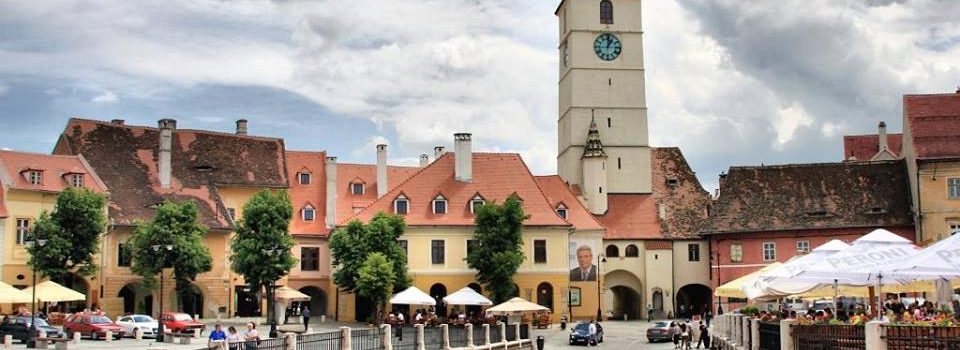- Duration: 3 Days
- Location: Departure from Cluj-Napoca
- Available Seat: Please contact us!
- Price: 203 €/person
Now a thriving modern city, Sibiu still preserves the traces of the flourishing medieval burg Hermannstadt of olden days, as well as buildings erected in Viennese baroque style after Transylvania became part of the Habsburg Empire in 1699.
Declared a reserve of medieval architecture, the eight-hectare city centre has entirely preserved its historic character. In 2007 Sibiu was the European Capital of Culture and since then, it is a tourist city par excellence.
Day 1, Friday
Cluj-Napoca – Sibiu
Arrival at the international airport in Cluj-Napoca. Departure to Sibiu. Dinner and overnight in a 4* hotel in the Old Center.
Day 2, Saturday
Sibiu – Cluj-Napoca
Visit Sibiu, the most representative city of the “Transylvanian Saxon” civilization. It is situated on the site of the Roman settlement Cedonia and it was first mentioned in documents in the 12th century under the name Cibidium. Nineteen groups of workers in different crafts helped fortify the city, which at one point had 39 defense towers. Because of the economic power, the city enlarged outside the walls and became an important cultural center of Transylvania. Continuing this cultural heritage, in 2007 Sibiu granted the status of European Cultural Capital.
The Large Square was the center of the old fortress, initially a grain marker and then a place for public gatherings. It is dominated by the unmistakable outline of The Council Tower, a symbol in itself, mentioned even in the 14th century. The most important architectural monument in the square is the Brukenthal Palace, built in baroque style at the end of the 18th century, which shelters valuable art collections, being the first museum in the country.
The Small Square (the merchants and craftsmen square) is connected with the Large Square and the Huet Square by few narrow streets and arched corridors. The Bridge of Lies is the first cast iron bridge in Romania (1859) and is connected to many legends, according to which the person who lies on the bridge will cause it to collapse.
The Huet Square is dominated by the Evangelist Church, with a 73 m tall tower, the tallest in Transylvania. The Passage of the Stairs runs alongside medieval walls and connects the Lower City (the city’s oldest area) with the Upper City through stairs, passages, corridors and bastions, a great touristic attraction.
Retour at Cluj-Napoca for dinner and overnight in a 4* hotel.
Day 3, Sunday
Cluj-Napoca
Depending on the departure time, visit the city of culture and a prestigious university center: The Roman Catholic St. Michael’s Church (built in the 14th – 15th centuries in gothic style; its 80 m high neo-gothic tower was built in the 19th century and offers a great view over the city), the old citadel fortifications, the University Babes-Bolyai, The Tailors’ and the Cobblers’ Bastions, The Calvaria Church, The Piarists’ Church, Matei Corvin’s House, The Orthodox Cathedral (which combines Byzantine and Brancoveanu architectural styles and elements), The National Theatre, The Franciscans’ Complex, The Reformed Synagogue, The Botanical Garden (with over 10 000 species of plants throughout the world), Iuliu Maniu street (also known as The Street in the Mirror).
End of our services. Departure.
OPTIONAL
ASTRA MUSEUM
It is located two km away from the centre of Sibiu on the way to Rasinari. The open-air museum Dumbrava Sibiului is reminiscent of the rural atmosphere of the previous centuries. The museum houses almost 300 different homes and artifacts, including: peasant houses, folk art from the 13th to the 20th century, household objects, ceramics, furniture, and folk weavings. The museum is also the setting for frequent folk art fairs and folk shows.
TURDA SALT MINE
In Turda city there is a salt mine with salt extractions during the antiquity. The mine continuously produced table salt from the Middle Ages (the mine being first mentioned in 1075) to the early 20th century. After its renovation in 2010, Turda Salt Mine was ranked by Business Insider as the most beautiful underground place in the world. Likewise, Salina Turda is ranked 22 among the most spectacular tourist destinations in the world.
Today, it has been transformed into an incredible underground theme park. When you visit, you’ll head down about 400 feet before reaching the submerged wonderland. Once inside, you’ll find an amphitheater, a bowling alley, a mini golf course, ping pong courts and underground lake with paddle and row boats, and even a Ferris wheel.
PRICE:
203 €/person
*78 €/person SGL Supplement
Included:
- Accommodation 2 nights in 4* hotels
- Half-board (check-in with dinner and check-out with breakfast)
- Rent-a-car for 3 days
- Road taxes
- Travel files
- Telephonic emergency call and support 24/7
Not included:
- Air tickets
- Entry tickets and taxes for cameras and filming
- Driver, fuel and parking taxes
- Round transfers
- Tips
Note
- Rates do not apply during the main holidays (Easter, Christmas and New Year) and during great events (festivals, concerts, fairs).
- The price is calculated on a base of 2 persons. For other group size, please contact us.

